Despite its creepy name, the Bloody Mary philodendron is a striking and elegant houseplant that will quickly become a focal point of any room.
It’s an unusual and beautiful plant that isn’t as well known as some of the other philodendron varieties.
This could be because the Bloody Mary philodendron is rare and not as readily available, which is a real shame since this absolutely beautiful plant is fairly easy to care for.
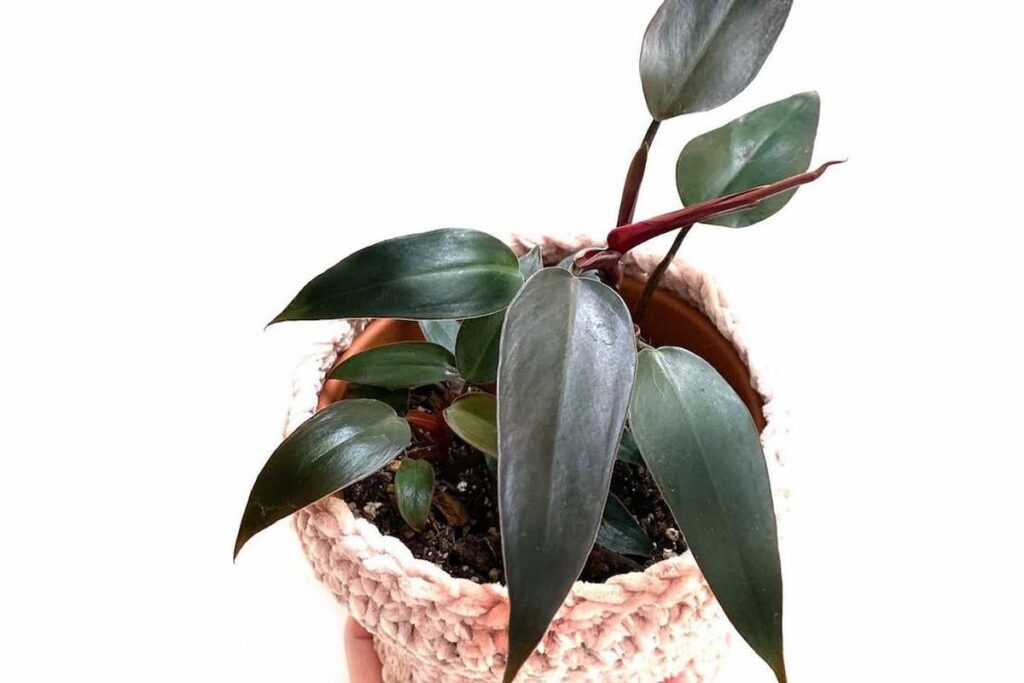
Table of Contents
Is there such a thing as bloody mary philodendron?
Bloody Mary Philodendron is a rare variety of the philodendron species that produces deep red stems. The new leaves are a stunning burgundy color, but will change to green as they age. The Bloody Mary philodendron has a trailing nature, which makes it a good choice for hanging baskets.
Like other philodendrons, the Bloody Mary cultivar needs bright, indirect light, and not giving the plant enough sun will cause it to become leggy. This means the plant will produce more stems and fewer leaves.
This plant should never be subjected to direct sun, however, as it will scorch and burn its foliage.
The Bloody Mary philodendron does have specific watering needs that must be met if you want to successfully grow this plant.
Like other philodendrons, the Bloody Mary thrives in damp, but not soggy soil. It will need to be watered whenever the top inch of water starts to dry out.
What’s bloody mary philodendron’s scientific name?
The scientific name for this houseplant is exactly that: Philodendron ‘Bloody Mary’. It is native to the Brazilian rainforest, where it has warm temperatures and high humidity throughout the entire year, which is why trying to have these same conditions in your home will help it thrive.
Like other philodendrons, the Bloody Mary can grow quickly and will need regular pruning to keep its size in check.
Bloody Mary is just one of the many different philodendron cultivars out there. In fact, there are more than 450 different philodendron varieties all over the world. They are available in various growing habits, color, texture, and size.

How to care for a philodendron bloody mary
The best way to care for a Philodendron Bloody Mary is to try and emulate its natural, tropical environment. This involves providing it with bright, indirect light, plenty of warmth and humidity, well-draining soil, good hydration, and seasonal feeding. Occasional pruning and cleaning also help your Philodendron Bloody Mary’ overall well-being.
Philodendron Bloody Mary make great houseplants, and if you have any hesitation about their care, worry no further. These gracious green beauties are low-maintenance and straightforward in terms of their needs, making them perfect for even beginner plant parents.
Bearing in mind that Philodendron Bloody Mary are tropical plants, the best environment you can offer them is one where they’ll have a sunny spot with lots of light, relative humidity, and plenty of moisture.
In good news, most homes are already set up for this with East and South-facing windows and a generalized humidity level of around 50%. To supplement the rest of their care needs, you just need to ensure your Philodendron Bloody Mary stays hydrated, is fed with both good soil and that you occasionally fertilize your philodendron.
Best soil for Philodendrons
Miracle-Gro Tropical Potting Mix
Light and well-draining (perfect for avoiding root rot) while being packed with just the right nutrients – that will feed your plant for up to six months. The best soil for keeping your philodendron healthy and strong.
In the following sections, we’ll look at Philodendron Bloody Mary care in greater detail to equip you with everything you need to help your houseplants thrive.
How much light does a philodendron bloody mary need?
Philodendron Bloody Mary prefer at least six to eight hours of bright, indirect sunlight each day. As their leaves can be vulnerable if they receive too much light, keep an eye out for any signs of sunburn on your Philodendron Bloody Mary’s leaves, such as yellowing leaves or brown spots appearing.
Most (if not all) plants depend on sunlight energy to grow, and Philodendron Bloody Mary are no different. Native to tropical America, they’re accustomed to dappled light from the jungle canopies above them, which you can try to mimic in the home with clever positioning.
In the winter, when it starts to cool down, and there is less indoor sun available, a Philodendron Bloody Mary’s light needs can be augmented with a bit of time spent outdoors on a sheltered patio or balcony. The fresh air will do them good, too.
Find out more: Philodendron Light Needs: The Ultimate Guide
What is the right temperature for philodendron bloody mary?
Your Philodendron Bloody Mary will thrive in temperatures between 75°F and 85°F (23°C to 29°C). While they can survive at lower temperatures than this, don’t let them stay for too long anywhere less than 65°F (18°C) as your plant may not survive.
Clearly some plants, like Philodendron Bloody Mary, like it hot. However, the real kicker is ensuring your Philodendron Bloody Mary are placed in an area with mid-to-high humidity.
When should I fertilize my philodendron bloody mary?
Philodendron Bloody Mary likes some fertilizer every now and again. In fact, they do their best when they are fed twice a month during their active growing season, which is the spring and summer. However, you shouldn’t fertilize your Philodendron Bloody Mary during its dormant period in the cooler months.
This is because feeding the plant during this time can interfere with its natural growing cycle.
Overall, though, occasional feeding with a balanced fertilizer is greatly beneficial for Philodendron Bloody Mary, especially at the start of their growing seasons in the spring and summer months.
Best fertilizer for Philodendrons
Jack’s Classic 20-20-20 All Purpose Fertilizer
A great fertilizer with the perfect balance for your philodendron. Simply dissolve in water and feed your plant to watch it thrive.
If you think about it, these jungle-dwellers are used to all the rich, dense nutrients they have access to from the forest floor, which can’t be substituted by typical potting soil.
An all-purpose liquid fertilizer at half strength is a good way to replace their natural feeding schedule, providing them with an extra dose of energy for new growth.
What are the best humidity levels for a philodendron bloody mary?
Philodendron Bloody Mary prefer humidity levels of around 65% to 80%. Given that they are native to tropical Central and South America, they thrive in humidity conditions similar to their natural habitat. However, most homes won’t reach these levels, so you may need to boost this for your Philodendron Bloody Mary to thrive.
Houseplants that receive adequate amounts of sunlight daily generally don’t require supplementary humidity, particularly if you consider most homes fall in the 40% to 50% range. However, with their tropical inclinations, Philodendron Bloody Mary can benefit from a little extra care in this regard.
The easiest, in my opinion, is to invest in a small plug-in humidifier. Alternatively, you can rest your Philodendron Bloody Mary on a damp pebble tray, making sure not to let their roots touch the water.
Alternatively, if you have a whole collection of houseplants, cluster them together so they can benefit from each other’s transpiration processes. It has the added benefit of looking great too!
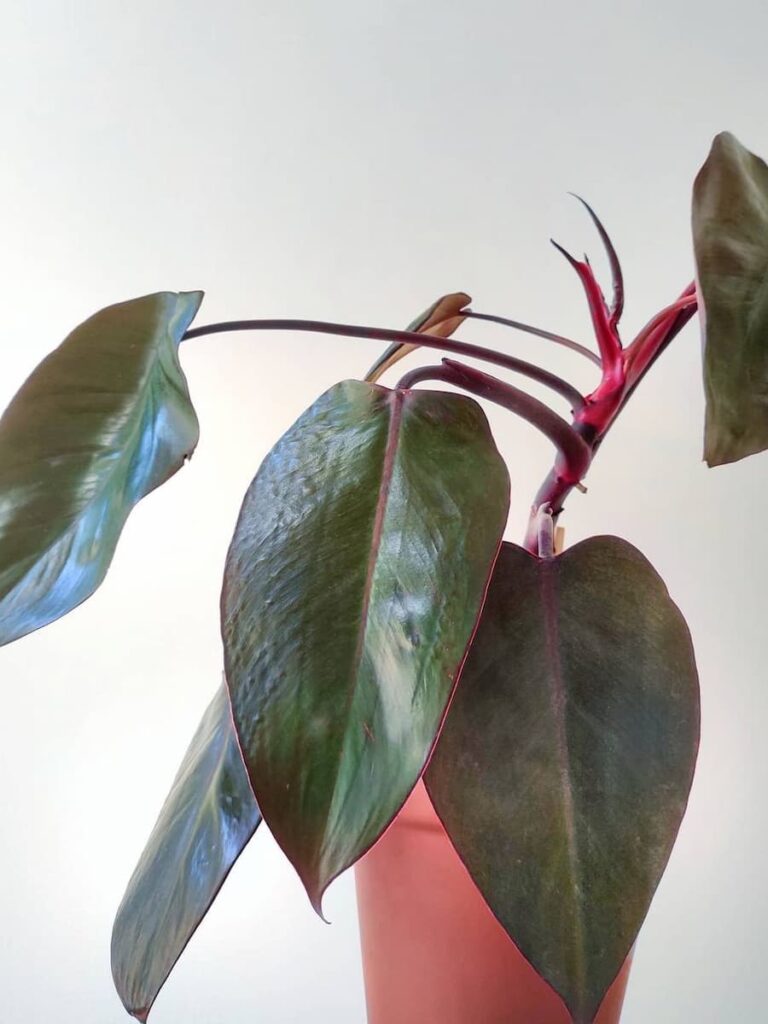
What soil is best for philodendron bloody mary?
A Philodendron Bloody Mary’s soil mix should be loosely clustered, nutrient-rich, and well-draining. The high nutrient level emulates its natural habitat, where plant material in the rainforest falls onto Philodendron Bloody Mary and nourishes them. Having light and airy potting mix helps to avoid the soil staying too soggy, which can lead to root rot.
While many Philodendron Bloody Mary varieties have aerial roots as well as ground-dwelling (terrestrial) roots, they receive the bulk of their vitamins and minerals from their soil, making it an essential part of their fundamental care.
Top pick: My preferred soil for Philodendron Bloody Mary is the Miracle-Gro Tropical Potting Mix (check the latest price here).
It’s very well draining and will feed nutrients to your Philodendron Bloody Mary for up to six months. For a tropical plant like the Philodendron Bloody Mary, it’s got everything you need.
Buying pre-blended Philodendron Bloody Mary soil from most garden centers is a simple option. Alternatively, you can easily mix your own by combining potting soil with chunky bits of bark (grab some here) and moisture-retentive perlite (get it here).
If you’re buying your Philodendron Bloody Mary pre-potted, they’ll likely arrive in appropriate soil from the get-go. Even so, you’ll need to replace their soil every 18 to 24 months to prevent a build-up of salts or eliminate any beasties and creatures like pests, fungi, or bacteria, so make sure you’re replanting them in the best soil for philodendrons so they continue to thrive.
Indeed, this is a good maintenance practice for all houseplants, not just Philodendron Bloody Mary!
How often should you water philodendron bloody mary?
You should water your Philodendron Bloody Mary when the top two inches of its soil has dried out, which you can test by sticking your finger into your plant’s potting mix. In summer, this will be around once per week, but may be less frequent in the cooler months.
It’s always good to have a watering schedule for your plants, but with so many factors (like season and sunlight) at play, I prefer to meet my Philodendron Bloody Mary’s watering needs as required – by waiting for their top inch of soil to dry out before hydrating.
The reason for this is that the leading cause of fatality in Philodendron Bloody Mary is root rot, which they tend to contract from overly soggy soil or from standing in pooled water. As they’re pretty drought-tolerant, it’s best to err on the side of caution and only water philodendrons as they need it rather than strictly once-per-week.
That said, when you do water them, a hearty dose of moisture is great, provided it doesn’t make their soil soggy and heavy, which weighs down on their root systems.
Should I prune my philodendron bloody mary?
You should prune your Philodendron Bloody Mary from time to time as part of their regular maintenance, with spring being the best time of the year to do this. Removing dead foliage or browning stems will allow robust leaves and vines to draw in more sunlight and stop your plant from wasting energy.
Just like humans shower, cut their hair, and clip their nails, Philodendron Bloody Mary can do with occasional grooming, especially when it comes to eradicating old or dying growth. Fortunately, trimming your philodendron really isn’t hard to do.
When it comes to cleaning, remember that each large leaf of your Philodendron Bloody Mary is full of sunlight receptors that are easily blocked by dust or grime. Wiping down your leaves with a damp cloth keeps them clean and free to function at their best.
When should I repot my philodendron bloody mary
The Philodendron Bloody Mary is not a plant that needs to be repotted regularly, with it often only needing to be transplanted every two to three years. With that said, however, you should repot your Philodendron Bloody Mary if you see roots growing out of the drainage holes.
In fact, this plant does well when it is rootbound. That said, when you do transplant a Philodendron Bloody Mary, do so in spring before the plant starts to produce new growth, and select a pot that is about 3 sizes larger than the current pot.
Alternatively, you can wait until fall to perform the transplant.
Find out more: 7 Simple Steps to Repot Philodendrons (+ When To Do It)
How to propagate a philodendron bloody mary
The easiest way to propagate your Philodendron Bloody Mary is to root it in water. Simply place your cutting into a jar with water in it and place it in a warm sunny spot, and wait. Refresh the water once a week to keep it oxygenated and, in six to eight weeks, new roots will appear.
At that point, your Philodendron Bloody Mary cutting will be ready for transplantation!
Philodendron Bloody Mary can be propagated from stem cuttings, provided they have a visible node and a leaf or two to draw in moisture from the air. You can either root your cuttings in water first or plant them directly into soil.
Alternatively, if you only have a small piece of stem, you can try to root them in a nutrient-rich growing medium with concentrated humidity.
That is, a second option is to place your cutting directly into a planter with soil. This is slightly riskier as they require a lot of humidity to make up for the moisture they’d usually draw via roots, but it can be equally effective with proper care.
If your cutting has no leaves, try laying it on a bed of peat moss and covering the tray or container with plastic to retain humidity. While this method isn’t always effective, it’s worth a try to avoid throwing away any pieces of your precious plants.
Find out more: 10 Easy Steps to Propagate Philodendron Cuttings
Is Philodendron bloody mary same as majesty?
Bloody Mary philodendron and Majesty philodendron are actually two different cultivars of the philodendron plant. You can tell the difference between the two by looking at the plant’s stems and foliage. Bloody Mary has blood red stems, while Majesty has deep purple to almost black stems.
Furthermore, a mature Bloody Mary philodendron has leaves that are green, while the mature Majesty leaves are almost black.
Bloody mary philodendron vs red emerald
While the Bloody Mary philodendron and the Red Emerald philodendron do look similar in many ways, there are a few stark differences that make it easy to tell the two apart. Specifically, the Bloody Mary philodendron produces stems that are a much darker red color than the Red Emerald.
Additionally, the undersides of the Red Emerald leaves are a pinkish red color, while the undersides of the Bloody Mary philodendron leaves are a deeper red.
Bloody mary philodendron vs royal queen
The Royal Queen philodendron produces glossy dark foliage that unfurls a rich burgundy color, but changes to black and then dark green once the plant matures. Like the Bloody Mary philodendron, this cultivar also has red stems, but they are not as blood red as the Bloody Mary variety.
Both the Royal Queen and Bloody Mary philodendron require the same level of care, and they can make good companion plants for your indoor garden.
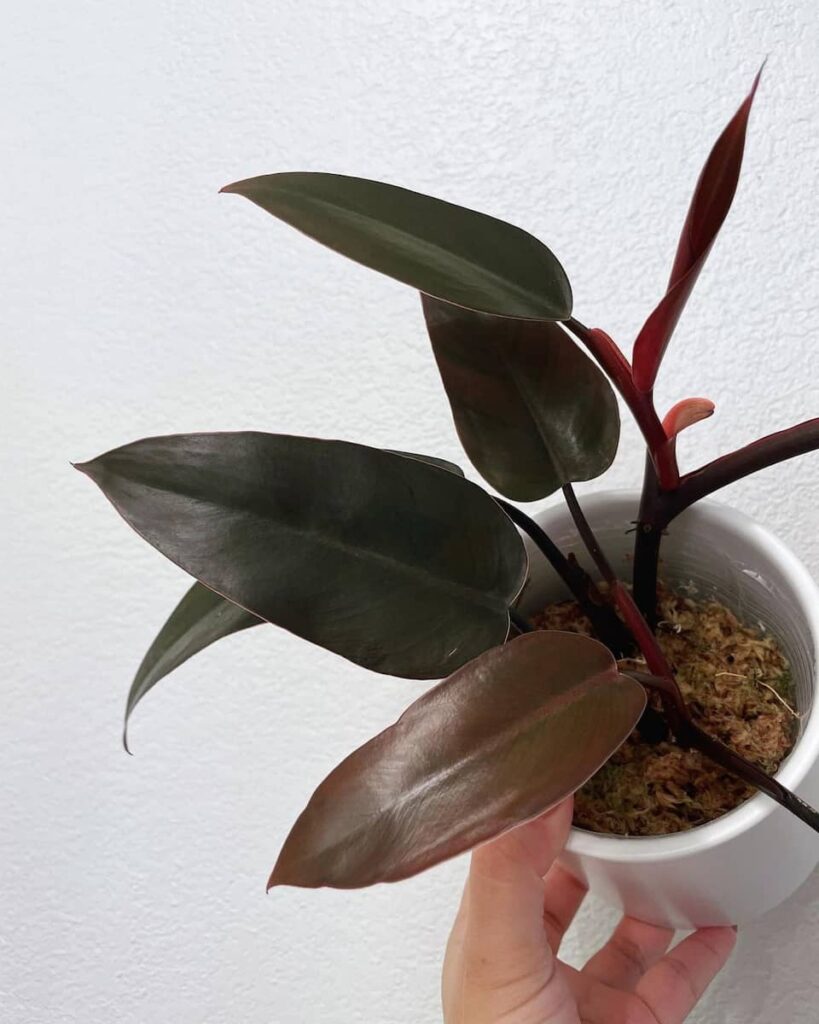
Is bloody mary philodendron rare?
The Bloody Mary philodendron is a rare cultivar, which means it may be a bit more difficult to obtain this plant. That doesn’t mean it’s impossible, just that you are probably not going to find Bloody Mary at your local garden center.
Instead, you may be forced to order the Bloody Mary philodendron from an online merchant.
With that said, however, you should first consider speaking to your local nursery and see if they could possibly order a Bloody Mary philodendron for you. While it isn’t guaranteed that they can or will order this plant for you, it is always worth a shot to help support your local businesses.
Another option is to reach out to your local garden club. The club itself, or one of its members, may be able to point you in the right direction of a reputable source for where you can buy the Bloody Mary philodendron.
What’s a standard bloody mary philodendron price?
Because the Bloody Mary philodendron isn’t as relatively available as other types of philodendron, you can expect to pay a bit more for this cultivar. The standard price for the Bloody Mary philodendron ranges from $20 for a simple cutting to $80 or more for a Bloody Mary in a 4-inch pot.
Keep in mind, however, that the price of this plant can vary depending on several factors, including the age and size of the plant. Expect to pay more for a Bloody Mary philodendron that is mature and well established.

How do you make a philodendron bloody mary bushy?
The best way to make a Philodendron Bloody Mary bushy is to prune it in its growing season, which is spring and summer. Make sure you remove any dead or dying leaves, as this ensures your plant doesn’t spend energy on this foliage and will instead focus on new growth.
Funnily enough, regularly trimming your plant is actually key to maximizing your philodendron’s growth rate.
Regularly turning your plant so that all its angles receive sunlight is another good way to ensure consistent, rounded, and aesthetic growth with a clustered appearance to make your philodendron fuller.
You can also use a moss pole so that your Philodendron Bloody Mary has space to climb upwards, which is what it would do in its natural environment – aiming upwards towards a source of light.
Is bloody mary philodendron a climbing or crawling philodendron?
Bloody Mary philodendron is a climbing philodendron that produces long stems that can reach up to 12 feet in length. This plant is also a fairly fast grower, and can grow up to 3 inches a week when given its ideal growing conditions.
Remember that how fast the Bloody Mary philodendron grows is directly connected to how healthy it is and how well it is cared for. For example, if you don’t give this plant enough sunlight, it will start to produce fewer leaves and more stems, making the plant more leggy.
While this isn’t necessarily harmful to the plant, it does have a negative impact on the appearance of the Bloody Mary philodendron.
The best way to promote fast and healthy growth is to make sure you are doing everything possible to recreate the plant’s native habitat.
This means temperatures between 60 and 80 degrees, humidity levels of at least 50 percent, watering when the top inch of soil is dry, bright sunlight that is not direct, and soil that drains well and is rich in organic matter.
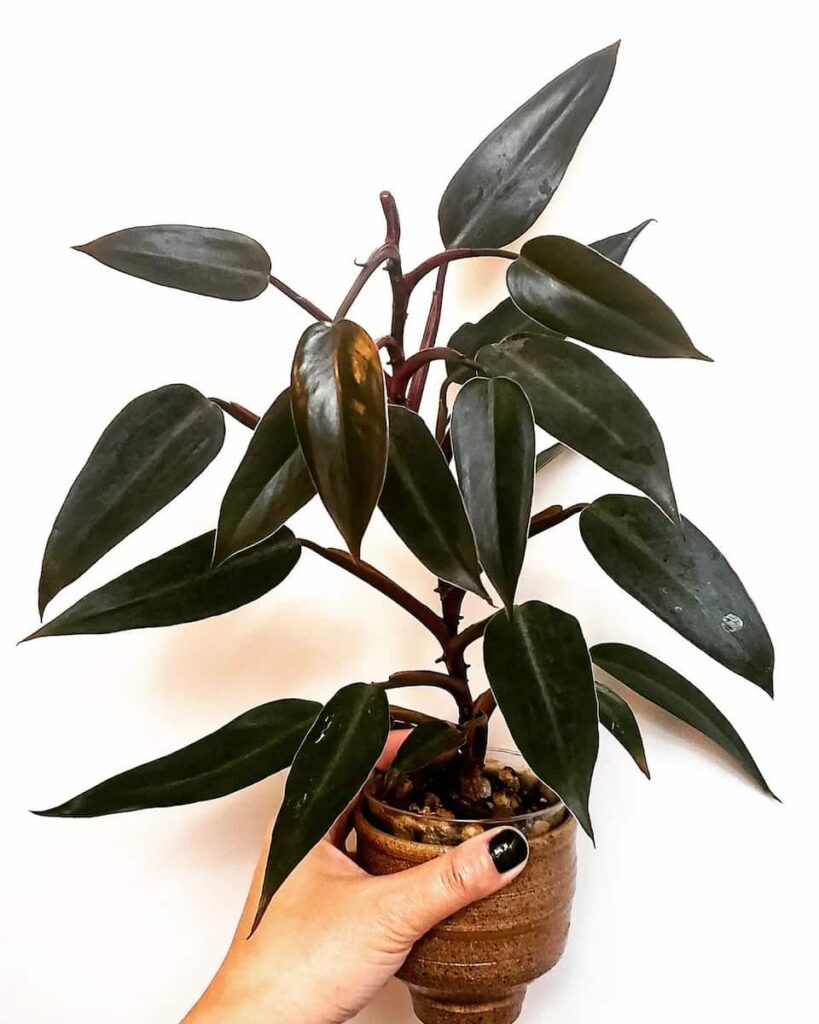
Are philodendron bloody mary toxic?
Philodendron Bloody Mary are toxic to humans and animals, as they contain sharp calcium oxalate crystals that cause skin irritation through direct contact, or gastrointestinal distress and other potentially dangerous symptoms when ingested. All parts of the plant contain these crystals, which are most prevalent in its sap.
While Philodendron Bloody Mary are indisputably beautiful in the home, it is best to keep them away from curious kids and pets, as skin contact and ingestion can be highly irritating at best and have real health consequences at worst.
These plants’ sticky white sap is full of needle-like calcium crystals. When they make contact with bare skin, they can cause welts or irritating rashes, which, fortunately, can usually be treated with a topical skin ointment.
Be aware: Ingestion of any part of a Philodendron Bloody Mary can cause swelling of the throat tissue, nausea, dizziness, diarrhea, and other symptoms of gastrointestinal distress. In a worst-case scenario, ingestion can cause difficulty breathing, in which case, medical treatment should be sought as a matter of urgency.
While this all sounds very daunting, the good news is that these plants don’t taste good, so there is no real reason (other than curiosity or carelessness) why rogue children or pets would eat them. Even so, prevention is better than cure, so place your plants out of reach if you’re concerned they may get chomped.
Why are my philodendron bloody mary’s leaves turning yellow?
There are a few reasons why Philodendron Bloody Mary leaves turn yellow, but the primary cause is overwatering, with yellowing leaves being an early sign of root rot. Damaged roots cannot transport nutrients, oxygen, and water to a plant’s leaves, which causes cell death, and by default, turns them yellow.
I find watering my plants to be the most cathartic exercise on earth. However, with some trial and error, I’ve learned that my Philodendron Bloody Mary, in particular, doesn’t do well with being over-loved.
While they’re super hardy, too much hydration can quickly cause root rot in philodendrons – a fungal or bacterial infection that destroys your plant’s root system.
Therefore, if you notice yellowing leaves on your philodendron, run a diagnostic immediately. Is your soil damp or soggy? Allow it to dry out, which may reverse some of the damage. Lots of sun helps. Or if the damage is progressed, try repotting your Philodendron Bloody Mary, removing damaging roots in the process.
A secondary cause of yellowing leaves is chemical burn, which your Philodendron Bloody Mary may contract from over-fertilization. In this case, transplantation is also recommended, followed by a restriction of your feeding practices.
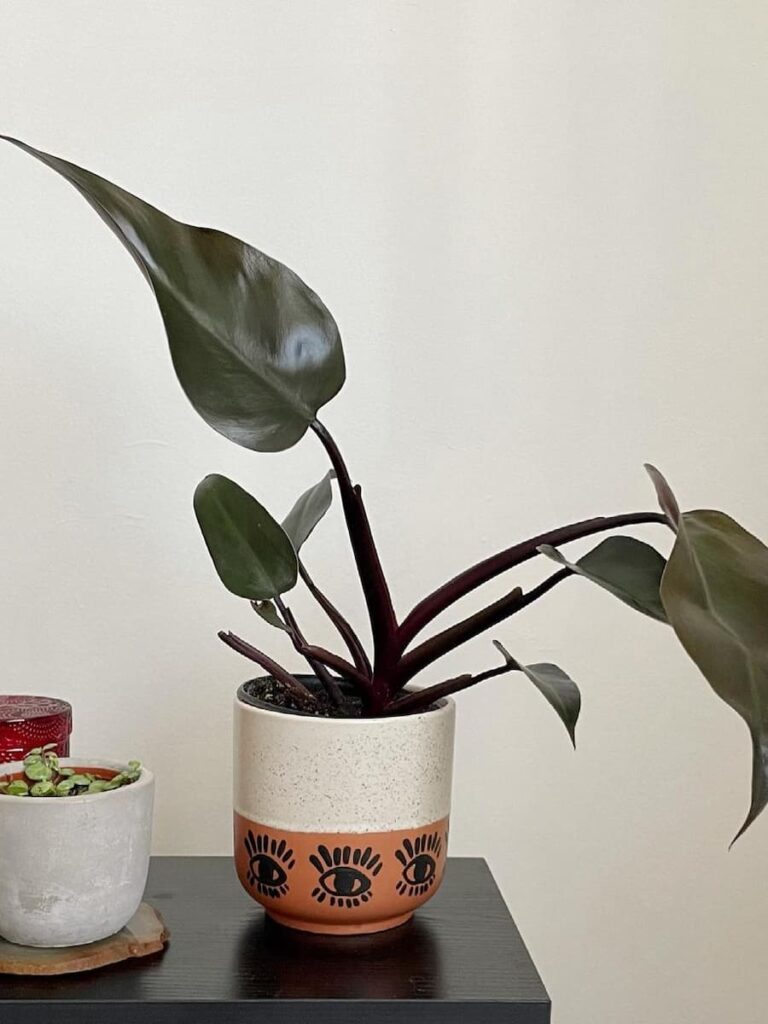
Why is my philodendron bloody mary drooping?
Drooping and wilting in Philodendron Bloody Mary is more often than not related to watering practices. Too little water can cause fatigue which will make your plant look droopy, while too much water (or root rot) can also cause ill health. Generally, when a plant wilts, it is trying to communicate that it’s unwell.
While a drooping Philodendron Bloody Mary is distressing, it’s not usually terribly serious and most likely due to dehydration. This can be solved with a dose of water and sunlight and, of course, more consistent care going forward. In no time, your plant should be back to its old self.
Conversely, if this doesn’t do the trick, your philodendron leaves curling may indicate an underlying issue like root rot, which, ironically, is caused by overwatering. If you suspect this is the case, you may be best off transplanting your Philodendron Bloody Mary into fresh soil and readjusting your watering schedule.
A third cause of drooping is related to light. If a Philodendron Bloody Mary isn’t receiving enough sun, it will tell you by dropping its leaves and wilting. Remember, six to eight hours a day is critical, and if you can’t provide this, mitigate potential drooping with supplementary grow lights.
Related: 10 Causes Of Your Philodendron Not Growing (+ How to Fix It)
Why are there brown spots on my philodendron bloody mary?
Like yellowing and drooping, brown spots on a Philodendron Bloody Mary are a sign of a health ailment. Browning, in particular, is mainly caused by pest infestations or bacterial and fungal infections. The best way to get rid of brown spots is to identify the cause and then treat your plant accordingly.
None of us want to see our Philodendron Bloody Mary suffer, and brown spots usually aren’t a very good sign. If you notice your philodendron leaves turning brown, the first thing you want to do is identify the cause, whether it be pests or soil-related.
In the case of creepy crawlies, you can treat your Philodendron Bloody Mary by washing it down with a horticultural soap, followed by a wipe with neem oil. Remove damaged growth, and give your plant lots of love, water, and light.
On the other hand, bacterial and fungal infections are best treated by getting rid of old soil. I highly recommend transplanting your Philodendron Bloody Mary (preferably in spring or summer), and cutting away any visible root and leaf damage, provided it’s not more than 30% of your plant’s total volume.
Brown spots on philodendrons can also be caused by sunburn, but in this case, they’ll look more like a sheen than a spot, per se. Sunburn can be prevented by keeping your Philodendron Bloody Mary out of direct light.
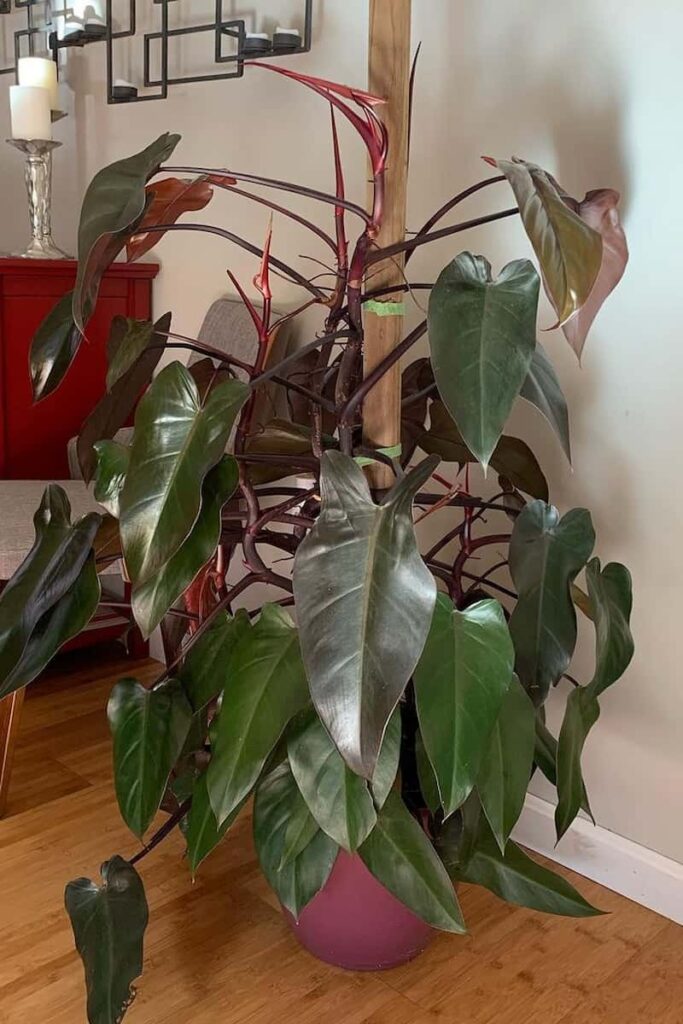
Why are my philodendron bloody mary’s leaves falling off?
When a Philodendron Bloody Mary’s leaves start to drop, it is more often than not a sign of either overwatering or underwatering. Root rot, a consequence of too much water, can cause leaves to wilt, curl, and fall. Underwatering, conversely, sees them dry and turn crisp before dropping.
Bloody Marys are great communicators and will tell you when there is something in their environment they don’t enjoy. As hardy plants, they don’t have many health issues, so any sudden onset of leaf drop is a cause for immediate concern.
As mentioned, this is usually related to watering practices, with the first sign of an issue being wilting, curling, or dried leaves. You should adapt your hydration timeframes accordingly.
If watering is not the problem, it may be that your Bloody Mary is scorching (you’ll note its leaves start turning pink), in which case you should move it to a shadier spot as soon as possible.


